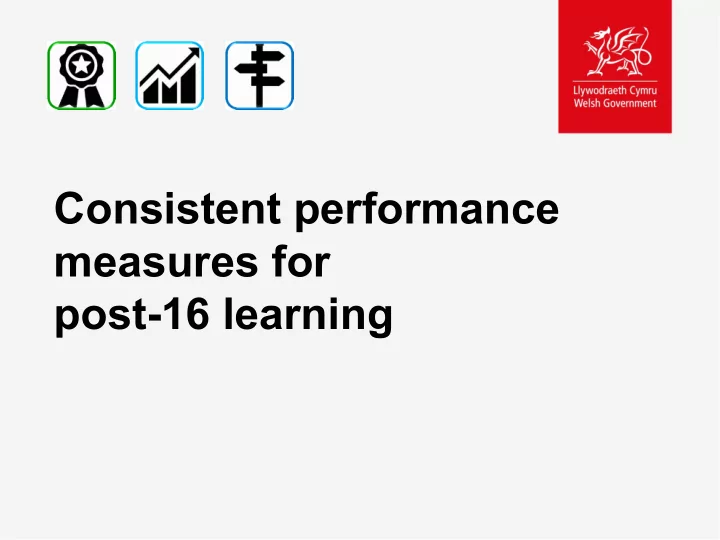

Consistent performance measures for post-16 learning
The aim To develop a new set of learner outcome measures that can be applied consistently across FE and sixth forms, to inform: • Performance monitoring and improvement • Estyn inspections • Learner and parental choice of institution and learning programme • Evaluation of Welsh Government policies and investments
The measures Achievement Post-16 value added Destinations
Consultation 30 January 2017 – 1 May 2017 58 responses 7% Local authorities (4) 26% Further education institutions (15) 26% (15) Schools Regional education consortia 10% (6) 26% Unions (15) 5% (3) Other stakeholders
Consultation: key messages • Consensus on the need for consistent measures • Broad agreement with the proposed measures • Devil is in the detail!
Consultation: key messages • ‘Positive’ outcomes don’t look the same for every learner, and not always easy to capture in statistical measures • Comparability between providers given different sizes, cohorts and contexts • Parity of esteem – age, vocational/academic, full-time/part-time • Risk of unintended consequences – gaming, learner choice, inclusion
Consultation: key messages • Range of views regarding one-year vs two- year outcomes for A levels • Unions concerned about any potential increase in workload for staff • Vital to take account of learners’ starting point (value added) • Sufficient lead in time for providers to plan and adjust
Achievement • Proposed key principles: Measure outcomes against the learner’s original goal (two-year measures where applicable) • A-level achievement: Retention of learners for the full two-year programme Attainment of grades A*-A, A*-C and A*-E • Vocational achievement: Main qualification attainment • Welsh Bacc data recording guidance published, new baseline measures from 2015/16 onwards
Achievement: data issues • Learners changing providers between AS and A2 year. • Potential for discrepancies between WED data and LLWR/Post 16 learning activity data. • Sixth forms: issues with data accuracy, including recording of programme fields, completion and transfers • FE: issues in relation to expected end dates, transfers, Welsh Bacc, programme completion. • Unable to ‘backtrack’ problems calculating two-year measures if Year 1 incorrect
Achievement: next steps • Issue experimental data tables to local authorities and FE institutions • Set up meetings to discuss methodology – Local authorities on a regional consortia basis – FE MIS Managers – Estyn • Continue informal consultation with stakeholders to refine approach and work through data issues
Achievement • Experimental data tables issued 12 July via DEWi • Annotated version of the data tables has been produced to explain data discrepancies • Importance of ensuring post-16 collection is accurate • New post-16 collection management validation report on DEWi • Post-16 collection – between 19 September and16 October 2017
Post-16 value added • Measure of learner progress above and beyond what would normally be expected • Three indicators: 1. Volume of entries 2. Points score per learner 3. Average grade per entry • FFT Ltd appointed as contractor to develop the approach and provide annual value added reports • Pilot carried out April – June 2017
Post-16 value added Headlines from consultation: • General support for a national value added model. • Some consortia, providers and LAs noted the investment made to date into commercially available products. • Some concern that the model would unintentionally focus on academic qualifications. • Respondents suggested the model should: be responsive provide subject specific estimates take account of wide variations in deprivation differentiate between academic and vocational qualifications not introduce additional administrative burdens.
Post-16 value added First iteration will include learners: • In all Welsh colleges and school sixth forms • Aged 16-18 at 31st August prior to the academic year • Attempting at least one graded qualification equivalent in size to an A level in the relevant academic year • Matched to Key Stage 4 prior attainment Future work streams: • Level 2 and below • Older learners • Target setting
Destinations • No measures in place currently • Experimental statistics on educational destinations in 2014 and 2015, using matched data • Taking part in large-scale UK Government data linking programme, including educational, earnings and benefits data Pilot for FE/WBL in summer 2017 Scope for much wider analysis and research, including schools, in future
Timetable Proposed measure Provisional timetable Key milestones All FE institutions and schools with sixth forms April 2017 received post-16 value added pilot reports. Post-16 value added Consultation exercises to gather feedback on the draft June 2017 measure and reporting formats. Issue experimental data tables to each individual college and school with sixth form based on 2015/16 Learner Achievement 12 July 2017 data to illustrate outcomes based on the proposed measures (these will not be published). Experimental analysis on the matched data and Destinations October 2017 starting to define a measure for positive destinations. New measure in place. Post-16 value added October 2017 Begin testing on additional work streams i.e. Level 2 and below, older learners and target setting. Data from the 2016/17 academic year will be issued to each individual college and school with sixth form to illustrate outcomes based on the proposed measures Learner Achievement February 2018 (these will not be published at provider level, but consideration will be given to publication as experimental statistics at an all-Wales level). Data from the 2017/18 academic year will be issued to each individual college and school with sixth form and Learner Achievement February 2019 will be published at an all-Wales and provider level.
Recommend
More recommend